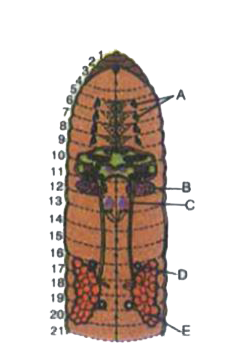X and Y are two human beings. The organ A in the reproductive system of X releases a mature gamete B once a month which goes into a tube-like structure C through a funnel-like opening. The organ D in the reproductive system of Y makes and releases gametes E which pass through a duct F and are introduced by an organ of Y, into the body of X. B and E fuse together in C to form a new cell G. The cell G divides repeatedly to form a ball of cells H which gets embedded in the lining of organ I of reproductive system of X where it grows and develops into a baby.
Name (i) cell G (ii) ball of cells II, and (iii) organ I.
To solve the question, we need to identify the various components mentioned in the scenario regarding the reproductive systems of X and Y. Here's the step-by-step solution:
Step 1: Identify Organ A
Organ A in the reproductive system of X releases a mature gamete B once a month. Since this is a female reproductive organ, Organ A is the ovary.
Step 2: Identify Gamete B
The mature gamete B released by Organ A is the egg (ovum).
Step 3: Identify Tube-like Structure C
The tube-like structure C that the egg travels through after being released is the Fallopian tube (also known as the oviduct).
Step 4: Identify Organ D
Organ D in the reproductive system of Y releases gametes E. Since Y is male, Organ D is the testes.
Step 5: Identify Gamete E
Gamete E released by Organ D is the sperm.
Step 6: Identify Duct F
The duct F through which the sperm passes is the sperm duct (vas deferens).
Step 7: Identify Cell G
When gamete B (egg) and gamete E (sperm) fuse together in the Fallopian tube (C), they form a new cell G, which is called the zygote.
Step 8: Identify Ball of Cells H
The zygote (cell G) divides repeatedly to form a ball of cells H, which is known as the embryo.
Step 9: Identify Organ I
The ball of cells H (embryo) gets embedded in the lining of organ I of the reproductive system of X, which is the uterus.
Final Answers:
(i) Cell G: Zygote
(ii) Ball of Cells H: Embryo
(iii) Organ I: Uterus
---
Organ A in the reproductive system of X releases a mature gamete B once a month. Since this is a female reproductive organ, Organ A is the ovary.
The mature gamete B released by Organ A is the egg (ovum).
The tube-like structure C that the egg travels through after being released is the Fallopian tube (also known as the oviduct).
Organ D in the reproductive system of Y releases gametes E. Since Y is male, Organ D is the testes.
Gamete E released by Organ D is the sperm.
The duct F through which the sperm passes is the sperm duct (vas deferens).
When gamete B (egg) and gamete E (sperm) fuse together in the Fallopian tube (C), they form a new cell G, which is called the zygote.
The zygote (cell G) divides repeatedly to form a ball of cells H, which is known as the embryo.
The ball of cells H (embryo) gets embedded in the lining of organ I of the reproductive system of X, which is the uterus.
(i) Cell G: Zygote
(ii) Ball of Cells H: Embryo
(iii) Organ I: Uterus
Topper's Solved these Questions
- HOW DO ORGANISM REPRODUCEBOOK - BETOPPERSCHAPTER - HOW DO ORGANISM REPRODUCEEXERCISE - COMPETITIVE WORKSHEET
44 Videos
- HOW DO ORGANISM REPRODUCEBOOK - BETOPPERSCHAPTER - HOW DO ORGANISM REPRODUCEEXERCISE - WORKSHEET 2
35 Videos
- HEREDITY & EVOLUTIONBOOK - BETOPPERSCHAPTER - HEREDITY & EVOLUTIONEXERCISE - COMPETITIVE WORKSHEET
34 Videos
- LIFE PROCESSESBOOK - BETOPPERSCHAPTER - LIFE PROCESSESEXERCISE - COMPETITIVE WORKSHEET
82 Videos
Similar Questions
Knowledge Check
Conglobate organ is a part of male reproductive system of
APrawnBCockroachCEarthwormDFrogConglobate organ is a part of male reproductive system of
APrawnBCockroachCEarthwormDFrogWhich is not the accessory duct in male reproductive system of human
AVas efferentBOviductCEpididymisDVas deferens
Organs of human male reproductive system which are not paired.
View SolutionOrgans of human male reproductive system which are not paired.
View SolutionWhere are gametes produced in the female reproductive system?
View SolutionIn the diagram of the reproductive system of earthworm A, B, C, D and E represent:

View SolutionThe reproductive organs in human females include
View Solution
